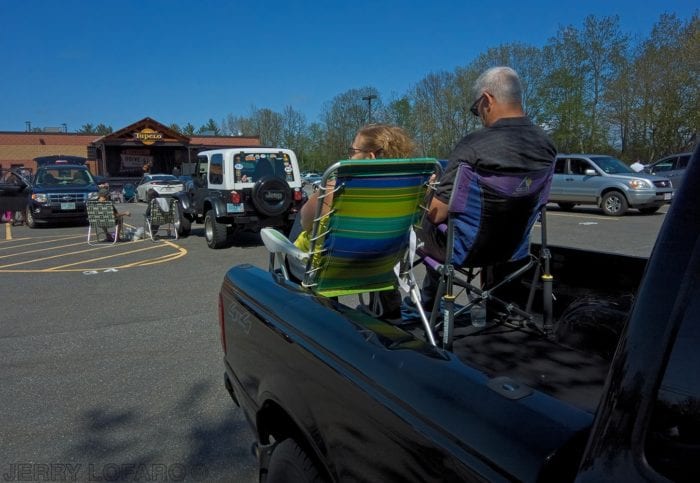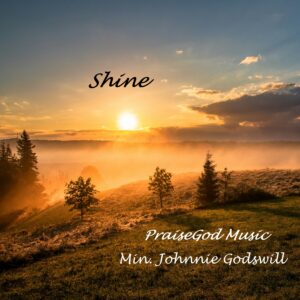

Photo by Jerry Lofaro via Tupelo Music HallMusic seems poised to return to the way it was presented for thousands of years before there was a formal music industry: A few elite artists subsidized by their wealthy patrons, while the rest of civilization heard music made by their neighbors at barn dances or at local celebrations.
The concert industry is done for a long time. But local live music is back—in a way.
Last weekend, something happened that hasn’t happened in two months: A ticketed live music event took place in New England. And it used a model likely to be seen at other live music venues this coming summer, one that’s intimate, outdoors, pricey, and distant.
The watershed show went down at the Tupelo Music Hall in Londonderry, New Hampshire, and was the first in a series of drive-in concerts in the parking lot. To kick things off, the venue hosted a pair of matinees with Granite State rocker Tim Theriault.
Tupelo’s remarkably well-planned design has taken into account multiple aspects of social distancing, from prepaid concession deliveries, to a reminder not to visit the occupants of neighboring cars. There’s even a request that shorter cars park in front so no views are blocked. Using a drive-in movie pricing model, tickets were $75 a carload. Comparably, prior to the onset of COVID-19, locals could catch Theriault gigging at pubs for little or no cover charge.
The drive-in series continues this weekend, with ’70s prog rock cult hero Kasim Soltan of Utopia, and follows the successful launch of another experimental model. The Saturday before, the Chicago-area nightclub SPACE sent local rock hero Jason Narducy to 20 yards and driveways. Each 30-minute set cost $450, including pizza, drinks, and dessert for 10 people (which, on a per person basis, isn’t far from what many were paying for a night of food, alcohol, and entertainment at Boston venues before the shutdown).
 Photo by Jerry Lofaro via Tupelo Music Hall
Photo by Jerry Lofaro via Tupelo Music Hall
Such experiments are welcome signs as it becomes clear that the return of live music as we’ve previously known it isn’t happening anytime soon. Gov. Charlie Baker’s mandate that no large public events or festivals take place this summer, coupled with common sense, resulted in the Lowell Folk Festival and Lowell Summer Music Series going on hiatus until 2021. Almost every other festival had already been canceled, and while there are tickets on sale for June and July concerts at large venues like the Xfinity Center and Rockland Trust Bank Pavilion, it’s hard to imagine them happening.
The picture is even worse for small local venues that operate on tight margins. In the best of times, their general admission and standing room setups are the antithesis of social distancing. For an idea of the potential harm of reopening too soon, one might look at South Korea. While that country has demonstrably handled COVID-19 far better than the US, it nevertheless saw a spike in cases traced to nightclubs and bars that were allowed to open their doors.
Things aren’t looking much better for the fall, when medical experts warn the virus could return with a vengeance. Recently, CelebritySeries optimistically put tickets on sale for long-ago contracted classical, jazz, and folk concerts. Just a few days later, though, a dozen of the shows had to be scrapped or moved after the New England Conservatory of Music announced that its venues would remain off limits to outside rentals for the next year. One of the innovative CelebritySeries experiments, their “Music For One” project of short one-on-one concerts, is being moved outside to adapt to COVID-19 times.
There’s also the question of who would go to an indoor show. Six in 10 Americans tell pollsters that they’re unlikely to attend a concert until a vaccine is available.
Meanwhile, an alternative scenario is being dreamed up by Michael Dorf, the owner of the City Winery chain, who is considering $800 tickets to see acts that normally play larger venues. While the few spared by the oncoming depression might pony up that kind of cash, for the rest of us, the real return to live music is more likely to be neighbors playing for each other. There’s reason to hope that small, spaced out, private, outdoor gatherings in yards and driveways will be safe and legal sometime this summer. There have already been outdoor singalongs from windows and sidewalks everywhere from Italy to Newton.
There’s likely to be plenty of local musicians who would love the chance to play for actual bodies instead of the webcams that have been their only audiences this spring. The folk house concert circuit, punk basement shows, the Caribbean sound systems at backyard cookouts, and homespun celebrations of neighborhood music makers like porchfests all thrived in the pre-COVID era. Sweaty mosh pits, food buffets, or close dancing with strangers remain a no-no, but music at home could still be enjoyed safely with far less modifications than a traditional venue would require.
For the rest of 2020, music seems poised to return to the way it was presented for thousands of years before there was a formal music industry: A few elite artists subsidized by their wealthy patrons, while the rest of civilization heard music made by their neighbors at barn dances or at local celebrations.
“It would be great if people with big yards could do something safely,” said Thalia Zedek, one of Boston’s most heralded indie musicians. Zedek had plans to spend the year touring the US and Europe as one-third of the band E, which released a new album a few weeks ago. Like most of her counterparts, Zedek has been livestreaming acoustic sets, “But I’m jonesing to get back with my band,” she said. For now, Zedek is trying to figure out if she can even go into a private rehearsal space with collaborators. After reading about how breath-intensive activities like singing can further the spread of droplets, she decided it’s not the best time—“even if you were in a larger basement where you could be further apart, because there’s still the potential for more exposure if the rehearsal runs for a couple of hours.”
“I’ve heard about some people rehearsing outside,” Zedek added, “but I’m not sure how long my neighbors would tolerate that.”
A summertime staple of the reggae and soca scene have been cookouts, supposedly private parties that are actually highly profitable jam-packed events hyped on flyers months in advance and open to anyone willing to pay an admission fee. Junior Rodigan, the don of the Boston reggae scene, says the only thing he could imagine happening in the near future would be “a neighborhood thing, where people just open their windows and stay in while someone plays in the street. It would be a block party of sorts with everyone on their balconies or backyards just listening.” Rodigan adds that while such a setup might entertain locked-down residents, “as a DJ and a sound system owner I would wanna know: Are we getting paid? Considering that we haven’t made a dime since March 14?”
 The newly formed National Independent Venue Association hired a lobbyist to advocate for local clubs.
The newly formed National Independent Venue Association hired a lobbyist to advocate for local clubs.
As both the president of New England Folk Festival Association and a host of her own house concert series, Janet Yeracaris would love to see live music make a quick return, but thinking of her own shows she said, “I think it’s still early to be trying to figure out how to get people together while still keeping distance. It’s something that would merit further discussion, but right now, I feel like we still don’t have solid information about what distances are safe, whether other measures (masks, cleaning protocols, etc.) are really effective, how the virus affects different people, and so on. While it would theoretically be possible to have people sit separately in a yard or driveway, there are still many logistical problems like bathrooms.”
Yeracaris points out another wrinkle. Not having food and drink is fine, but it takes some of the fun out of it. Is six feet really a safe distance if people are sitting for a period of time? Air mingles, and even with masks, distance becomes difficult. Also, sing-alongs and even talking circulate a lot of air between people. Live music outside is also a draw, so people tend to collect. Maybe less at someone’s house, but in public or accessible areas, heads instinctively gather, and that works against the goal of keeping people separate.
Of course, embracing small-scale neighborhood music doesn’t mean we should abandon the artists and venues who are suffering. The newly formed National Independent Venue Association came to the sad but smart conclusion that it needed to hire a lobbyist if local clubs were going to see any meaningful federal aid, and you can tell your congresspeople what you think here. And for artists who can’t visit your backyard this summer, tipping for livestreams and buying pre-recorded music and merch or even music lessons remains a crucial form of support.
If you’ve learned a few licks, jotted down some new lyrics, or discovered you can harmonize with others in your household, why not see if you can find a way to safely share it with your neighbors this summer, like this shirtless dude playing an Everly Brothers song on his porch in Malden? It could be the only live performance they enjoy this year.
This article was produced in collaboration with the Boston Institute for Nonprofit Journalism as part of its Pandemic Democracy Project.





